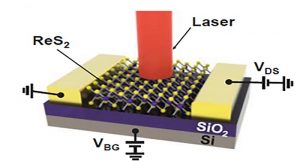
Schematic diagram of a few‐layer Rhenium disulfide-based photodetector.
The discovery of graphene in 2004 initiated a new era for 2D materials and their applications in technology. Since then, graphene has attracted much attention due to its thinness, flexibility, and extraordinary carrier transport properties. However, it suffers from a zero band-gap, which determines a semiconductor’s transport and optical properties, limiting its widespread application.
As a result of the enormous potential of 2D materials to enhance the technology sector, researchers have been actively searching for alternative 2D materials with enhanced properties to replace graphene. In this vein, 2D transition metal dichalcogenides (TMDs) are emerging as promising functional materials for post-silicon, high-performance devices, owing to their sizeable band-gaps, unique structures, and versatile properties.
Rhenium disulfide (ReS2) has very recently shown promise in this area due to its uniquely distorted octahedral crystal structure, which distinguishes it from more widely-known TMDs, such as MoS2 and WSe2. The unique structure of this anisotropic 2D material has endowed it with layer-independent electrical and optical properties, suitable for application in field effect transistors (FETs) and photodetectors. In addition, compared to widely known TMDs, ReS2 is a direct semiconductor irrespective of layer number.
A recent review by researchers from the Microelectronics Institute of Fudan University presented a comprehensive introduction to ReS2, exploring its fundamental properties as well as its potential to go beyond the capabilities of graphene as a 2D material in a wide range of applications.
To find out more, read the full article here: Electronic and Optoelectronic Applications Based on ReS2

















